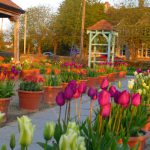Autumn Gardens
Autumn brings with it a final flourish before winter. All four gardens are still showing strongly. Although a number of the summer plants will depart for the year, this period sees the arrival of new autumn plants such as Asters and Anemones, alongside a host of grasses, now reaching their maturity.
As the season progresses, the colours of our gardens evolve. The hot reds, oranges and yellows of summer plants shift to a palette of blues, purples and pinks, as our autumn plants bear flower. In July our Dahlia garden erupts into a sea of colour as all our gardens strike their full potential.

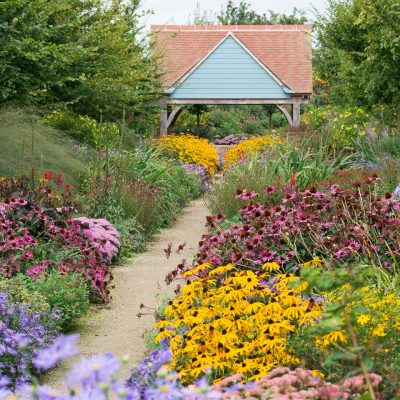
Hornbeam Walk
The summer/autumn transition sees a number of new plants coming into flower, down our Hornbeam Walk. Traveling down the path Asters spring up at regular intervals. The 12 varieties provide a wealth of fresh blues, purples, pinks and reds. As the Eremurus finish flowering for the year, varieties of Miscanthus and Molinia grasses take over the structural role, maintaining the integrity of the border into winter. This area of the garden has been designed with the year as a whole in mind.
Along with autumn’s new arrivals many of the earlier flowering plants continue to give a strong show into the later part of the year. Sedums ‘indian chief’ and ‘matrona’ for instance reach their maturity, providing depth with their full-leaves during the spring and summer months. The latter part of the year sees the development of intricate seed heads that, along with their subtle tones, are a great attraction for the local bees.
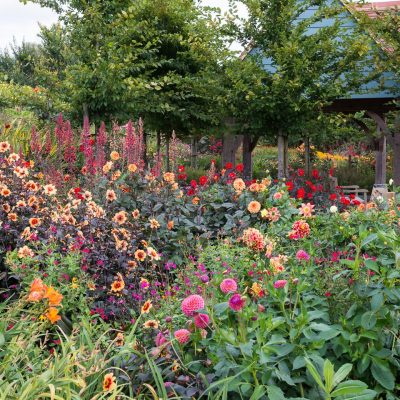
Hot Bank
This border carries on flowering right up until the first frosts of the year, which if we are lucky can be late autumn. This means that drifts of alstroemeria, dahlias and salvias will still be producing spectacular colour up to the end of November – which can be really quite surreal.
So do come and see our collection of plants from the Americas, as our planting exudes spontaneity, flamboyant, and a creativeness which truly sets it apart as one of the most unique borders in Britain today.
The Annual Border
By September the annual border is at its absolute peak with over 5,000 plants producing over 126,000 flowers, which create successive billowing clouds of colour that compete for your senses, from fragrant nicotiana and salvias to the vibrant zinnias and titholonia.
The seed in this border only has six months of the year to germinate, grow into a mature plant, flower and set seed again, before the first late autumn frosts send it into a winter slumber. Where upon, the scattered seeds wait until the first few warm days of late spring to start growing again into the next fabulous display flowers for us all to enjoy.
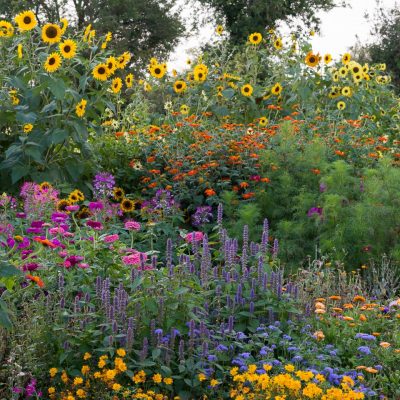
The Dahlia Garden
Moving back down the Hornbeam Walk you are presented with the new Dahlia garden. In this latter part of the year, the 9 varieties of grasses planted in this border emerge through the blanket of colour, emphasising the room-based planting structure that has been apparent throughout the summer, and earlier in the year, from our spring Tulip Garden.
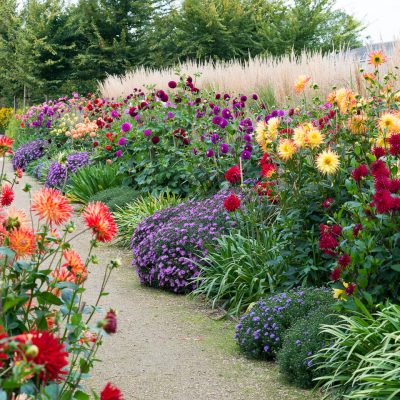
The majority of the planting remains consistent from the summer months. Along with the grasses taking greater precedence, as the Agapanthus bid their final farewell, a series of Asters take their place along the garden’s path and around its perimeter.
We have carefully selected 6 varieties of relatively low-growing Asters, to add a gentle border of blue and purple tones around the Dahlia garden. Along with the Asters there will also be 9 varieties of grasses, split into two distinct groups; those that intersect the ‘rooms’ and those that form the central spine of the border either side. Much like the Asters, the intersecting grasses do not overly impose upon the blanket of colour created by the Dahlias. They provide a new texture and soft depth to the visual experience. The grass spine however, contrasts strongly with the subtler planting seen elsewhere in this garden. Towards the end of summer and into autumn, 3 mixed grasses including Panicum Vergatum ‘rehnbraun’ all spike through the centre of the border at twice the height of the surrounding plants, holding high their glorious, purple seed heads.
All our 112 varieties of Dahlias should continue to flower throughout autumn, finally finishing with the first frost of winter.
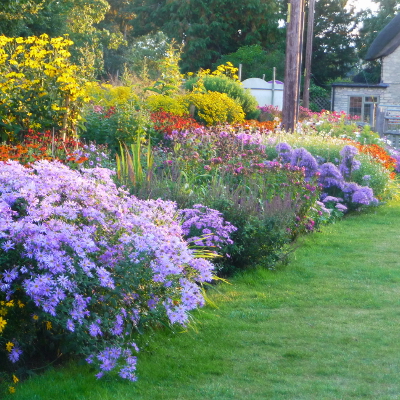
Traditional Perennial Border
Down the walkway towards the entrance of our shop, stretching out ahead of you is the unmistakable site of our Traditional Perennial Border. As with all our other autumn gardens, care has been taken to ensure that this border will be showing with great vitality throughout the season, through to November.
By this time of the year the Phlox, Lilies and Monarda die back, opening out space for new plantings to take over. Aconitum, Anemones and Asters emerge through the foliage bringing with them a second-wave of seasonal colour.
Purples, blues and pinks dominate the autumn planting of our border, reflecting the season. The colour palette of the border is toned down from that of the summer.
The four tiered planting structure continues to provide great depth to the overall appearance of the border. Many of the tallest plants such as Euphatoriem ‘russenshrim’ and Innula ‘racemosa,’ chosen to sit at the back, will continue to flower and, as the season progresses, will hold form – even when their colour is diminishing.



Making the most of what we have in our Traditional Perennial Border, and as part of a desire to maintain a garden in flower for as long a period as possible, by carefully pruning the Helleniums and Penstemons at the end of July, we achieve a second flowering of these stunning plants from October. This helps maintain the fullness and variety you will find in all our gardens this season and throughout the year.
